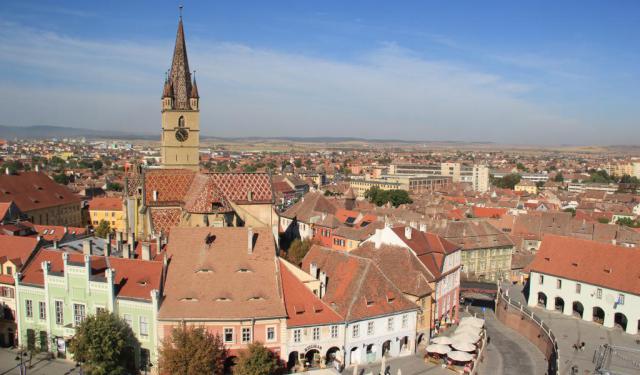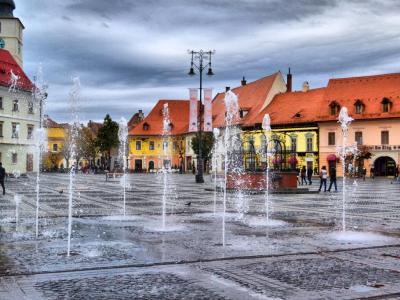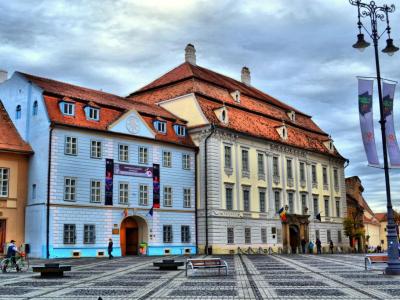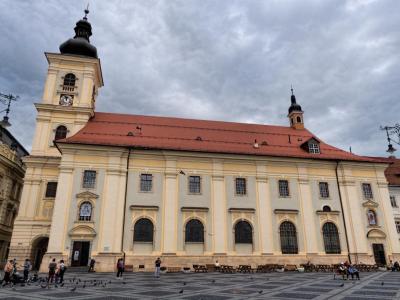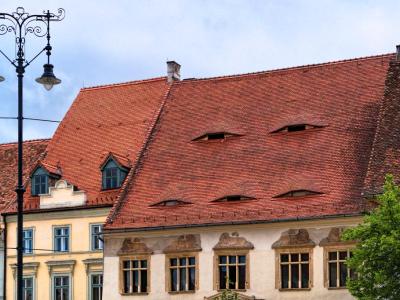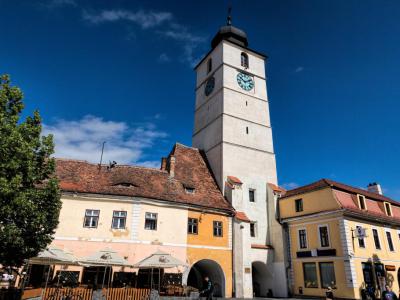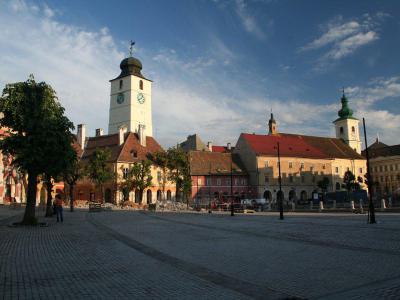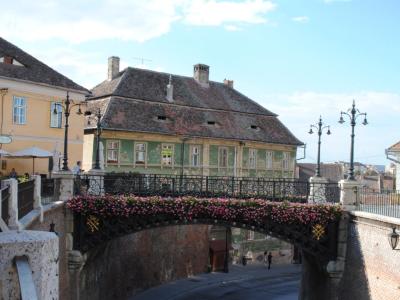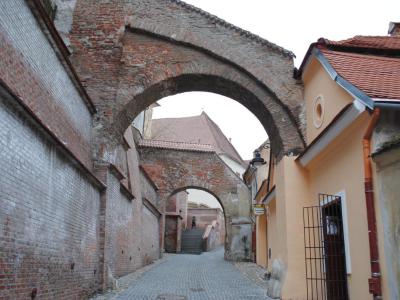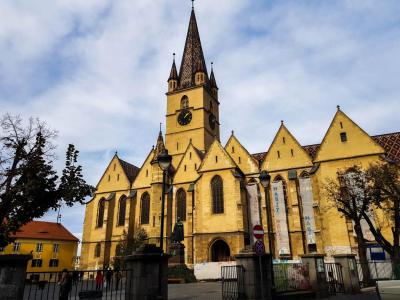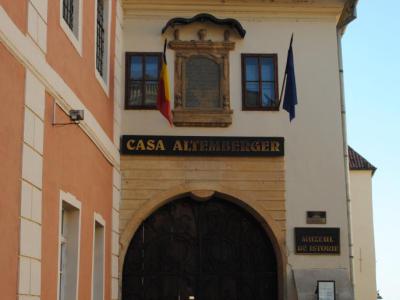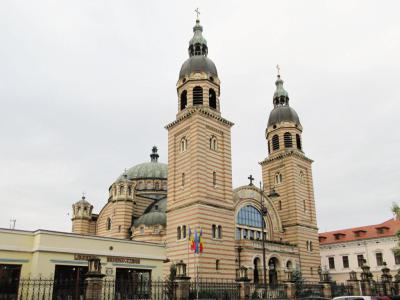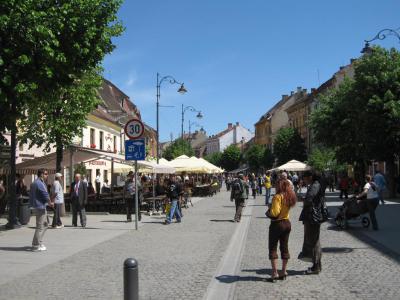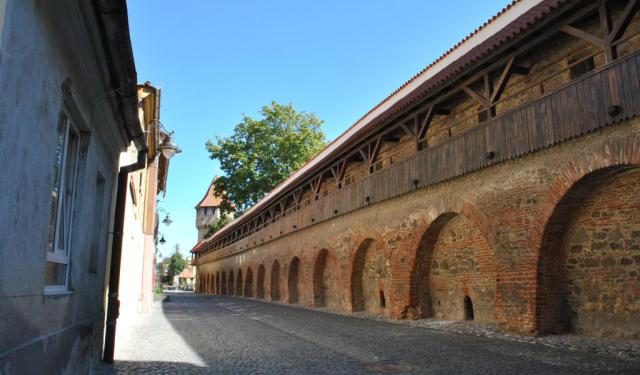Sibiu Introduction Walking Tour (Self Guided), Sibiu
Nestled in the heart of Romania's Transylvania, Sibiu is one of the most visited cities in Eastern Europe, and for a good reason! Its ancient beauty restored to its full glory in a historic center can easily steal your heart. Affectionately known as "The Town with Eyes" for its historical buildings with partly open rooftops, the city beckons travelers with its captivating architecture and enchanting ambiance.
The name "Sibiu" has its origins in the Bulgar-Turkic word "Sibin" or "Sebin," which means "rejoice." Founded in the 12th century by Saxon settlers hailed from various parts of the Holy Roman Empire and the Kingdom of France, some 200 years later the city emerged as an important trade center, with 19 guilds.
In 1699, following the Ottomans' withdrawal, Sibiu became the capital of the Principality of Transylvania, and over time, gained more importance as home to the first Romanian-owned bank and the seat of the Romanian Orthodox Church's Metropolitan.
After World War I, despite its predominantly German population, Sibiu transitioned to Romania. In the mid-20th century, many ethnic Germans emigrated to West Germany and Austria. Still, a resilient Transylvanian Saxon community remained, including Klaus Iohannis, the former mayor of Sibiu, from 2000 to 2014, who subsequently became Romanian President.
One of the city's most prominent attractions is the Large Square (Piata Mare) which exudes medieval charm with its colorful surroundings like the imposing Brukenthal National Museum, the Holy Trinity Church (Biserica Sfânta Treime), and the actual “Eyes of Sibiu,” a line of rooftops with small windows, to which the city owes its nickname.
Speaking of rooftops, for the panoramic vistas thereof you can ascend the iconic Council Tower (Turnul Sfatului) which stands tall over the city just around the corner from the Large Square.
In its turn, the Small Square (Piata Mica) is another gem lined with picturesque buildings and home to the famous Bridge of Lies (Podul Minciunilor), where legends of truth-telling are put to the test. Some distance away, the Passage of the Stairs (Pasajul Scărilor) is a quaint alleyway that leads you to the Lutheran Cathedral of Saint Mary, a stunning example of Gothic architecture.
Meanwhile, the Holy Trinity Cathedral (Catedrala Mitropolitana) showcases Romanian Orthodox beauty and grandeur.
Sibiu's historic charm and cultural richness are truly unparalleled, making it a destination that deserves a place on every traveler's itinerary. So, take our self-guided tour and create your own memories of this enchanting Transylvanian jewel!
The name "Sibiu" has its origins in the Bulgar-Turkic word "Sibin" or "Sebin," which means "rejoice." Founded in the 12th century by Saxon settlers hailed from various parts of the Holy Roman Empire and the Kingdom of France, some 200 years later the city emerged as an important trade center, with 19 guilds.
In 1699, following the Ottomans' withdrawal, Sibiu became the capital of the Principality of Transylvania, and over time, gained more importance as home to the first Romanian-owned bank and the seat of the Romanian Orthodox Church's Metropolitan.
After World War I, despite its predominantly German population, Sibiu transitioned to Romania. In the mid-20th century, many ethnic Germans emigrated to West Germany and Austria. Still, a resilient Transylvanian Saxon community remained, including Klaus Iohannis, the former mayor of Sibiu, from 2000 to 2014, who subsequently became Romanian President.
One of the city's most prominent attractions is the Large Square (Piata Mare) which exudes medieval charm with its colorful surroundings like the imposing Brukenthal National Museum, the Holy Trinity Church (Biserica Sfânta Treime), and the actual “Eyes of Sibiu,” a line of rooftops with small windows, to which the city owes its nickname.
Speaking of rooftops, for the panoramic vistas thereof you can ascend the iconic Council Tower (Turnul Sfatului) which stands tall over the city just around the corner from the Large Square.
In its turn, the Small Square (Piata Mica) is another gem lined with picturesque buildings and home to the famous Bridge of Lies (Podul Minciunilor), where legends of truth-telling are put to the test. Some distance away, the Passage of the Stairs (Pasajul Scărilor) is a quaint alleyway that leads you to the Lutheran Cathedral of Saint Mary, a stunning example of Gothic architecture.
Meanwhile, the Holy Trinity Cathedral (Catedrala Mitropolitana) showcases Romanian Orthodox beauty and grandeur.
Sibiu's historic charm and cultural richness are truly unparalleled, making it a destination that deserves a place on every traveler's itinerary. So, take our self-guided tour and create your own memories of this enchanting Transylvanian jewel!
How it works: Download the app "GPSmyCity: Walks in 1K+ Cities" from Apple App Store or Google Play Store to your mobile phone or tablet. The app turns your mobile device into a personal tour guide and its built-in GPS navigation functions guide you from one tour stop to next. The app works offline, so no data plan is needed when traveling abroad.
Sibiu Introduction Walking Tour Map
Guide Name: Sibiu Introduction Walking Tour
Guide Location: Romania » Sibiu (See other walking tours in Sibiu)
Guide Type: Self-guided Walking Tour (Sightseeing)
# of Attractions: 12
Tour Duration: 2 Hour(s)
Travel Distance: 2.0 Km or 1.2 Miles
Author: DanaOffice
Sight(s) Featured in This Guide:
Guide Location: Romania » Sibiu (See other walking tours in Sibiu)
Guide Type: Self-guided Walking Tour (Sightseeing)
# of Attractions: 12
Tour Duration: 2 Hour(s)
Travel Distance: 2.0 Km or 1.2 Miles
Author: DanaOffice
Sight(s) Featured in This Guide:
- Piata Mare (Large Square)
- Muzeul National Brukenthal (Brukenthal National Museum)
- Biserica Sfânta Treime (Church of the Holy Trinity)
- Ochii Sibiului (Eyes of Sibiu)
- Turnul Sfatului (Council Tower)
- Piata Mica (Small Square)
- Podul Minciunilor (Bridge of Lies)
- Pasajul Scarilor (Passage of the Stairs)
- Catedrala Evanghelica (Evangelical Cathedral)
- Altemberger House History Museum
- Catedrala Mitropolitana (Holy Trinity Cathedral)
- Nicolae Balcescu Street
1) Piata Mare (Large Square) (must see)
Large Square, situated in the heart of Sibiu, serves as the historic center of the city, with roots dating back to 1366 when the third fortification belt was completed. Originally identified as a cereal market in 1411, this square evolved into the nucleus of the old city from the 16th century onward. Throughout its history, the square underwent various name changes, including King Ferdinand Square between the world wars, Republic Square during the communist era, and, since 1990, it has reclaimed its original name.
Key structures define the square's character. The Tailors' Guild building on the northern side, dating back to 1466, joined later by the Jesuit Church and seminar in the 18th century, contribute to the square's architectural tapestry. The Brukenthal Palace, constructed on the west side, and the Land Credit Bank building from the early 20th century enhance the square's aesthetics.
Historically, the Large Square hosted significant events, from public gatherings to executions. The square featured a fountain in 1538 and the infamous pole of infamy in 1550. A statue of Roland and a scaffold in front of house no. 15 played roles in the square's history. The "lunatic cage" from 1724 to 1757 and the 1734 installation of Nepomuk's statue marked distinct periods. Unfortunately, post-1948 changes led to the removal of historical elements, replaced by a park in 1984 and later featuring the statue of scholar Gheorghe Lazăr in 1986.
Noteworthy are the iconic "eyes of the city," visible roof windows, and wind flags that once adorned every house, now surviving on the Council Tower and a neighboring building, representing either construction years or guild emblems. The Large Square stands as a testament to Sibiu's rich medieval heritage.
Key structures define the square's character. The Tailors' Guild building on the northern side, dating back to 1466, joined later by the Jesuit Church and seminar in the 18th century, contribute to the square's architectural tapestry. The Brukenthal Palace, constructed on the west side, and the Land Credit Bank building from the early 20th century enhance the square's aesthetics.
Historically, the Large Square hosted significant events, from public gatherings to executions. The square featured a fountain in 1538 and the infamous pole of infamy in 1550. A statue of Roland and a scaffold in front of house no. 15 played roles in the square's history. The "lunatic cage" from 1724 to 1757 and the 1734 installation of Nepomuk's statue marked distinct periods. Unfortunately, post-1948 changes led to the removal of historical elements, replaced by a park in 1984 and later featuring the statue of scholar Gheorghe Lazăr in 1986.
Noteworthy are the iconic "eyes of the city," visible roof windows, and wind flags that once adorned every house, now surviving on the Council Tower and a neighboring building, representing either construction years or guild emblems. The Large Square stands as a testament to Sibiu's rich medieval heritage.
2) Muzeul National Brukenthal (Brukenthal National Museum)
The Brukenthal National Museum stands as a cultural gem with a rich history dating back to the late 18th century. Founded by Samuel von Brukenthal, a prominent figure and governor of the Grand Principality of Transylvania, the museum had its roots in the collections initiated around 1790 within his city palace.
Officially opened to the public in 1817, the Brukenthal National Museum holds the distinction of being the oldest institution of its kind on the territory of modern-day Romania. Over the years, it has evolved into a complex comprising six museums, each contributing to the cultural tapestry of the region. Although not separate administrative entities, these museums are strategically located around the city, offering unique and diverse cultural programs.
The Art Galleries, housed within the grand Brukenthal Palace, serve as a focal point for artistic exploration. This section of the museum boasts a remarkable collection of approximately 1,200 works representing the main European schools of painting from the 15th to the 18th century. Visitors can immerse themselves in the beauty of Flemish-Dutch, German, Austrian, Italian, Spanish, and French masterpieces. Beyond paintings, the Galleries feature extensive collections of engravings, books, numismatics, and minerals, providing a comprehensive and immersive experience for art enthusiasts and history aficionados alike.
As a testament to Baron Brukenthal's visionary commitment to the arts, the Brukenthal National Museum continues to be a cultural beacon, inviting visitors to explore the richness of European artistic heritage and offering a journey through time within its magnificent walls.
Officially opened to the public in 1817, the Brukenthal National Museum holds the distinction of being the oldest institution of its kind on the territory of modern-day Romania. Over the years, it has evolved into a complex comprising six museums, each contributing to the cultural tapestry of the region. Although not separate administrative entities, these museums are strategically located around the city, offering unique and diverse cultural programs.
The Art Galleries, housed within the grand Brukenthal Palace, serve as a focal point for artistic exploration. This section of the museum boasts a remarkable collection of approximately 1,200 works representing the main European schools of painting from the 15th to the 18th century. Visitors can immerse themselves in the beauty of Flemish-Dutch, German, Austrian, Italian, Spanish, and French masterpieces. Beyond paintings, the Galleries feature extensive collections of engravings, books, numismatics, and minerals, providing a comprehensive and immersive experience for art enthusiasts and history aficionados alike.
As a testament to Baron Brukenthal's visionary commitment to the arts, the Brukenthal National Museum continues to be a cultural beacon, inviting visitors to explore the richness of European artistic heritage and offering a journey through time within its magnificent walls.
3) Biserica Sfânta Treime (Church of the Holy Trinity)
The Church of the Holy Trinity, otherwise the Jesuit Church, stands as an architectural gem exemplifying the early Viennese Baroque style. Characterized by a simple yet elegant exterior, the church's interior is a rich tapestry of decorative elements such as bells, triglyphs, volutes, and shells, which are shared characteristics with other Baroque monuments in Sibiu. The rectangular hall structure of the church includes a tribune on the southern side, while the confession chairs bear testament to the Jesuit period.
The church's interior is adorned with a 1904 painting by the German artist Ludwig Kandler, depicting the aisle. Notably, the main shrine boasts an invaluable fresco portraying the Virgin and Child. The stained glass windows, crafted in 1901 in Budapest, add to the church's artistic allure. The organ, installed in 1860 and crafted by Karl Hesse of Vienna, enriches the auditory experience within this architectural marvel.
One of the church's significant interior elements is the funerary monument of General Count Otto Ferdinand Traum of Abensberg (1677-1747), a notable military commander in Transylvania. Positioned on the right side of the shrine, this monument, carved by Anton Schuchbanu of Cluj, pays homage to the historical legacy of the region.
The tower, completed in 1738, features an arched alleyway representation, symbolizing a connection between the Large Square and the Small Square of Sibiu. The tower's clock, dating back to 1838, proudly displays dials towards both squares, and a light turret adorns the opposite side of the tower's roof crest, completing the architectural ensemble.
The church's interior is adorned with a 1904 painting by the German artist Ludwig Kandler, depicting the aisle. Notably, the main shrine boasts an invaluable fresco portraying the Virgin and Child. The stained glass windows, crafted in 1901 in Budapest, add to the church's artistic allure. The organ, installed in 1860 and crafted by Karl Hesse of Vienna, enriches the auditory experience within this architectural marvel.
One of the church's significant interior elements is the funerary monument of General Count Otto Ferdinand Traum of Abensberg (1677-1747), a notable military commander in Transylvania. Positioned on the right side of the shrine, this monument, carved by Anton Schuchbanu of Cluj, pays homage to the historical legacy of the region.
The tower, completed in 1738, features an arched alleyway representation, symbolizing a connection between the Large Square and the Small Square of Sibiu. The tower's clock, dating back to 1838, proudly displays dials towards both squares, and a light turret adorns the opposite side of the tower's roof crest, completing the architectural ensemble.
4) Ochii Sibiului (Eyes of Sibiu)
The Eyes of Sibiu are the captivating eyebrow dormers that grace the rooftops of houses. Serving as both a symbol and a popular tourist attraction, these distinctive architectural elements have bestowed upon Sibiu nicknames such as "The City with Eyes," "The City Where Houses Don't Sleep," and the clever portmanteau "Seebiu." The eyes, characterized by their varying shapes, including trapezoid, rounded, and elongated forms, have become synonymous with the city's identity.
While some of these eyes date back to the 15th century, the majority were constructed during the 19th century, likely by local craftsmen, as they are prevalent not only in Sibiu but also in its surrounding areas. Rooted in Baroque architecture, these dormers were, in fact, designed as a practical element rather than a decorative one. Serving as a ventilation system for the attics of houses, they played a crucial role in maintaining proper airflow within the structures.
Despite legends suggesting that the eyes were built to instill fear in the populace, creating a belief that they were being watched, their true purpose as ventilation systems contradicts these myths. Over time, the Eyes of Sibiu have evolved into one of the city's most renowned symbols, drawing visitors and adding to the city's architectural charm.
In 2017, the eyes took on additional significance, becoming a symbol of Romania's anti-corruption movement. The organization "We see you from Sibiu" adopted the eyes as a representation of vigilance and transparency in the fight against corruption.
Beyond Sibiu, these distinctive dormers have found their place in the surrounding Sibiu County, with some examples extending to other nearby cities like Brașov and Făgăraș in the Brașov County. Unrelated instances can also be spotted in the city of Timișoara in western Romania, showcasing the widespread influence and charm of the Eyes of Sibiu. Additionally, similar eyebrow dormers adorn traditional rural Romanian houses and cule in the historical region of Oltenia, further highlighting their cultural significance and architectural appeal.
While some of these eyes date back to the 15th century, the majority were constructed during the 19th century, likely by local craftsmen, as they are prevalent not only in Sibiu but also in its surrounding areas. Rooted in Baroque architecture, these dormers were, in fact, designed as a practical element rather than a decorative one. Serving as a ventilation system for the attics of houses, they played a crucial role in maintaining proper airflow within the structures.
Despite legends suggesting that the eyes were built to instill fear in the populace, creating a belief that they were being watched, their true purpose as ventilation systems contradicts these myths. Over time, the Eyes of Sibiu have evolved into one of the city's most renowned symbols, drawing visitors and adding to the city's architectural charm.
In 2017, the eyes took on additional significance, becoming a symbol of Romania's anti-corruption movement. The organization "We see you from Sibiu" adopted the eyes as a representation of vigilance and transparency in the fight against corruption.
Beyond Sibiu, these distinctive dormers have found their place in the surrounding Sibiu County, with some examples extending to other nearby cities like Brașov and Făgăraș in the Brașov County. Unrelated instances can also be spotted in the city of Timișoara in western Romania, showcasing the widespread influence and charm of the Eyes of Sibiu. Additionally, similar eyebrow dormers adorn traditional rural Romanian houses and cule in the historical region of Oltenia, further highlighting their cultural significance and architectural appeal.
5) Turnul Sfatului (Council Tower) (must see)
The Council Tower is an iconic symbol of the city and has a rich history dating back centuries. It was originally built in the 13th century as part of the city's fortification system, which included defensive walls and towers. Over the centuries, it served various purposes, including as a guard tower and storage facility.
The Council Tower is an impressive example of medieval architecture. It stands at a height of approximately 73 meters (240 feet) and features a distinctive cone-shaped roof. The tower has undergone several renovations and reconstructions over the years, resulting in a blend of architectural styles, including Gothic and Baroque elements.
One of the notable features of the Council Tower is its astronomical clock, which was installed in the 17th century. The clock has intricate dials that display not only the time but also astronomical information such as the phases of the moon and the position of celestial bodies.
The main attraction of the Council Tower is the panoramic view it offers from its observation deck. Visitors can climb a series of narrow, winding stairs to reach the top of the tower, where they are rewarded with breathtaking views of Sibiu's historic old town, the surrounding countryside, and the distant Carpathian Mountains. It's a popular spot for both tourists and locals to capture stunning photographs of the city. Climbing the tower requires a moderate level of fitness due to the steep stairs, but the reward of the panoramic views makes it a worthwhile experience.
The Council Tower has been transformed into a cultural and touristic hub in Sibiu. It often hosts art exhibitions, cultural events, and historical exhibitions that provide insights into the city's rich heritage.
The Council Tower is an impressive example of medieval architecture. It stands at a height of approximately 73 meters (240 feet) and features a distinctive cone-shaped roof. The tower has undergone several renovations and reconstructions over the years, resulting in a blend of architectural styles, including Gothic and Baroque elements.
One of the notable features of the Council Tower is its astronomical clock, which was installed in the 17th century. The clock has intricate dials that display not only the time but also astronomical information such as the phases of the moon and the position of celestial bodies.
The main attraction of the Council Tower is the panoramic view it offers from its observation deck. Visitors can climb a series of narrow, winding stairs to reach the top of the tower, where they are rewarded with breathtaking views of Sibiu's historic old town, the surrounding countryside, and the distant Carpathian Mountains. It's a popular spot for both tourists and locals to capture stunning photographs of the city. Climbing the tower requires a moderate level of fitness due to the steep stairs, but the reward of the panoramic views makes it a worthwhile experience.
The Council Tower has been transformed into a cultural and touristic hub in Sibiu. It often hosts art exhibitions, cultural events, and historical exhibitions that provide insights into the city's rich heritage.
6) Piata Mica (Small Square)
The Small Square exudes historical charm and architectural significance, serving as a testament to the city's rich heritage. Formerly a craftsmen market, this square is divided by Ocnei Street, which gracefully descends below the iconic Bridge of Lies toward the Lower Town.
The Northern and Eastern sides of the square, shaped in a circular manner, trace the contour of the second fortification belt. This section features several symbolic landmarks of Sibiu, including the Council Tower, the Bridge of Lies, the House of Arts (formerly Butchers' Hall), and the Jesuits Church (Catholic).
On the left side of Ocnei Street, the buildings have a concave shape, following the contour of the first fortification belt that separates the Small Square from Huet Square. Dating back to the 14th to 16th centuries, these buildings, with one exception, lack the massive arched gates characteristic of the Large Square or Bălcescu Street.
Distinctive features of the houses in the Small Square include arched loggias on the ground floor, semi-opened towards the square, adorned with semi-circle arcades supported by bearing piles. These spaces once served as merchandise displays, housing the shops of craftsmen. The Small Square is seamlessly connected to the Large Square and Huet Square through narrow tunnels and paved lanes, each exuding a unique charm.
The buildings, characterized by their height and lenticular eyelets known as "the eyes of Sibiu," are all historical monuments. The Small Square stands as a captivating blend of architectural finesse, historical significance, and the bustling energy of its medieval origins, inviting visitors to step back in time and immerse themselves in Sibiu's enchanting past.
The Northern and Eastern sides of the square, shaped in a circular manner, trace the contour of the second fortification belt. This section features several symbolic landmarks of Sibiu, including the Council Tower, the Bridge of Lies, the House of Arts (formerly Butchers' Hall), and the Jesuits Church (Catholic).
On the left side of Ocnei Street, the buildings have a concave shape, following the contour of the first fortification belt that separates the Small Square from Huet Square. Dating back to the 14th to 16th centuries, these buildings, with one exception, lack the massive arched gates characteristic of the Large Square or Bălcescu Street.
Distinctive features of the houses in the Small Square include arched loggias on the ground floor, semi-opened towards the square, adorned with semi-circle arcades supported by bearing piles. These spaces once served as merchandise displays, housing the shops of craftsmen. The Small Square is seamlessly connected to the Large Square and Huet Square through narrow tunnels and paved lanes, each exuding a unique charm.
The buildings, characterized by their height and lenticular eyelets known as "the eyes of Sibiu," are all historical monuments. The Small Square stands as a captivating blend of architectural finesse, historical significance, and the bustling energy of its medieval origins, inviting visitors to step back in time and immerse themselves in Sibiu's enchanting past.
7) Podul Minciunilor (Bridge of Lies)
The Bridge of Lies, an iconic pedestrian bridge in the heart of Sibiu, is not only the first cast iron bridge in the country but also a vessel of intriguing legends that shroud its name. According to one popular tale, the bridge has an uncanny connection to truth-telling - it is believed to collapse if someone utters a falsehood while standing upon it. Another legend suggests that cunning merchants, attempting to deceive their clients, traversed the bridge, and those caught in deceit faced the consequence of being tossed off.
Further myths intertwine the bridge with tales of romantic rendezvous and broken promises. Young lovers, who pledged eternal love upon crossing the bridge, faced dire consequences if their vows turned out to be false. Another narrative weaves a story of freshwater mermaids residing in a lake beneath the bridge, luring their mortal lovers to meet them on the bridge before leaping back into the water when their clandestine meetings concluded.
Contrary to the imaginative myths, the name "Bridge of Lies" has a more straightforward origin. Initially called Liegenbrücke, German for "lying bridge" (lying as in "to lie down"), the name bears similarity to Lügenbrücke, meaning "bridge of lies" in German.
The bridge, supported by four arches crafted from cast iron adorned with Neo-Gothic motifs, proudly displays the coat of arms of Sibiu on its southernmost arch. The inscriptions "1859" and "Friedrichshütte" on the northernmost arch commemorate the year of creation and the foundry that contributed to the bridge's components. The intricate rails feature eight panels with circular shapes and Gothic decorations, adding to the bridge's architectural charm and mystique.
Further myths intertwine the bridge with tales of romantic rendezvous and broken promises. Young lovers, who pledged eternal love upon crossing the bridge, faced dire consequences if their vows turned out to be false. Another narrative weaves a story of freshwater mermaids residing in a lake beneath the bridge, luring their mortal lovers to meet them on the bridge before leaping back into the water when their clandestine meetings concluded.
Contrary to the imaginative myths, the name "Bridge of Lies" has a more straightforward origin. Initially called Liegenbrücke, German for "lying bridge" (lying as in "to lie down"), the name bears similarity to Lügenbrücke, meaning "bridge of lies" in German.
The bridge, supported by four arches crafted from cast iron adorned with Neo-Gothic motifs, proudly displays the coat of arms of Sibiu on its southernmost arch. The inscriptions "1859" and "Friedrichshütte" on the northernmost arch commemorate the year of creation and the foundry that contributed to the bridge's components. The intricate rails feature eight panels with circular shapes and Gothic decorations, adding to the bridge's architectural charm and mystique.
8) Pasajul Scarilor (Passage of the Stairs)
The Passage of the Stairs stands as a captivating stone and brick passage in the heart of Sibiu. Constructed in the 14th century, this architectural gem served a crucial role by connecting the Upper Town to the Lower Town, forming part of the third fortification belt that safeguarded the medieval city.
As an integral component of the 3rd enclosure of Sibiu's fortifications, which includes renowned structures like the Defense Towers, Carpenters' Tower, Potters' Tower, Arquebusiers' Tower, Gate Tower, and curtains dating back to 1357-1366, the Passage of the Stairs has earned its place on the List of historical monuments in Sibiu County since 2004.
This passage, often referred to as the "Wall with Needles," intricately weaves through the historic landscape, connecting the two parts of the city through a series of stairs and arches that gracefully envelop the walls of the fortress around the Evangelical Church. The defensive wall of the Upper Town, rising about 10 meters high in two terraces, is supported by robust buttresses resting on arches that extend over the buildings of the Lower Town, some dating back six centuries. At the summit of the passage, it converges with Odobescu Street, the Gate Tower, and the Old Town Hall, now home to the History Museum within the Brukenthal National Museum.
Over the years, the Passage of the Stairs has undergone restoration efforts in 1860 and 2006, with the City Hall of Sibiu investing significant resources to consolidate the soil, restore masonry, and pave the stairs for enhanced accessibility. Recognizing its historical significance, the passage gained international attention when the President of the European Commission, José Manuel Durão Barroso, visited in September 2007, pledging financial and logistical support for the preservation of Sibiu's rich cultural heritage.
The four houses lining this enchanting passage, numbered 1-4, have withstood the test of time, originating from the 15th and 16th centuries, undergoing modifications in the 18th century, and experiencing restoration in 1860. These houses, resonating with historical charm, were rightfully included in the List of historical monuments in Sibiu County in 2004.
As an integral component of the 3rd enclosure of Sibiu's fortifications, which includes renowned structures like the Defense Towers, Carpenters' Tower, Potters' Tower, Arquebusiers' Tower, Gate Tower, and curtains dating back to 1357-1366, the Passage of the Stairs has earned its place on the List of historical monuments in Sibiu County since 2004.
This passage, often referred to as the "Wall with Needles," intricately weaves through the historic landscape, connecting the two parts of the city through a series of stairs and arches that gracefully envelop the walls of the fortress around the Evangelical Church. The defensive wall of the Upper Town, rising about 10 meters high in two terraces, is supported by robust buttresses resting on arches that extend over the buildings of the Lower Town, some dating back six centuries. At the summit of the passage, it converges with Odobescu Street, the Gate Tower, and the Old Town Hall, now home to the History Museum within the Brukenthal National Museum.
Over the years, the Passage of the Stairs has undergone restoration efforts in 1860 and 2006, with the City Hall of Sibiu investing significant resources to consolidate the soil, restore masonry, and pave the stairs for enhanced accessibility. Recognizing its historical significance, the passage gained international attention when the President of the European Commission, José Manuel Durão Barroso, visited in September 2007, pledging financial and logistical support for the preservation of Sibiu's rich cultural heritage.
The four houses lining this enchanting passage, numbered 1-4, have withstood the test of time, originating from the 15th and 16th centuries, undergoing modifications in the 18th century, and experiencing restoration in 1860. These houses, resonating with historical charm, were rightfully included in the List of historical monuments in Sibiu County in 2004.
9) Catedrala Evanghelica (Evangelical Cathedral) (must see)
The Lutheran Cathedral of Saint Mary is an exquisite Gothic-style church. This cathedral is not only a significant religious site but also a remarkable architectural and cultural landmark. It was originally built as a Roman Catholic church but was later transformed into a Lutheran place of worship during the Protestant Reformation in the 16th century. It has since served as a symbol of the Lutheran faith in the region.
The cathedral is a prime example of Gothic architecture, characterized by its soaring spires, pointed arches, and intricate stone carvings. The exterior of the church is adorned with intricate sculptures and decorative elements that showcase the craftsmanship of the time.
The interior of the Lutheran Cathedral is equally impressive. Visitors are captivated by the soaring nave, tall stone columns, and beautiful stained glass windows. The altar, pulpit, and organ are exquisite examples of Baroque artistry, adding to the cathedral's overall grandeur.
The cathedral is renowned for its towering bell tower, which stands approximately 73 meters (240 feet) tall. It is the second-oldest clock tower in Romania, and the current clock dates from 1881. Visitors can climb to the top of the tower to enjoy panoramic views of Sibiu and its picturesque surroundings.
The cathedral is a venue for various cultural events, including classical music concerts and art exhibitions. Its acoustics make it an ideal setting for musical performances.
The cathedral is a prime example of Gothic architecture, characterized by its soaring spires, pointed arches, and intricate stone carvings. The exterior of the church is adorned with intricate sculptures and decorative elements that showcase the craftsmanship of the time.
The interior of the Lutheran Cathedral is equally impressive. Visitors are captivated by the soaring nave, tall stone columns, and beautiful stained glass windows. The altar, pulpit, and organ are exquisite examples of Baroque artistry, adding to the cathedral's overall grandeur.
The cathedral is renowned for its towering bell tower, which stands approximately 73 meters (240 feet) tall. It is the second-oldest clock tower in Romania, and the current clock dates from 1881. Visitors can climb to the top of the tower to enjoy panoramic views of Sibiu and its picturesque surroundings.
The cathedral is a venue for various cultural events, including classical music concerts and art exhibitions. Its acoustics make it an ideal setting for musical performances.
10) Altemberger House History Museum
The Altemberger House History Museum stands as a testament to the rich tapestry of the city's past, encapsulated within the walls of this historic building. Originally acquired in 1545 by the Magistrate of the city, the edifice served as the Town Hall for an impressive 400 years until 1948. Comprising 10 architectural units and fortified with the addition of a defensive tower, the Altemberger House is a masterpiece of civic Gothic architecture, ranking among the most significant in Romania and Southeastern Europe.
The roots of this architectural ensemble trace back to the late 13th century, with the construction of the dwelling tower-the oldest part of the complex. The museum's permanent exhibition, reorganized in 2006 and 2007, unfolds a narrative of local history that spans epochs and facets of human existence. Beginning with the Palaeolithic Period, the exhibition delves into the evolution of human settlements in Southern Transylvania, portraying life from caves to medieval interiors.
The showcase extends to illustrate various human activities, from game processing to the specialized production of guilds, emphasizing the Glasswork in Transylvania and the Guilds of Sibiu. The exhibition highlights social status and leadership through exhibits in the Roman Lapidarium and the Medieval Lapidarium, capturing the essence of the Magistrate of Sibiu. Warfare is explored through arms and armors, providing insights into weapons, tactics, logistics, and organizational aspects.
Religious beliefs, an integral part of human life, are depicted from Prehistory to elaborate liturgical rites, featuring cultic items in the Liturgical and Lay Silverware section. The exhibition further explores the significance of coins and medals in societal contexts. The tour concludes with a presentation of the Southern Transylvania Movement for National Emancipation, spanning events from the 18th to the 20th century.
The roots of this architectural ensemble trace back to the late 13th century, with the construction of the dwelling tower-the oldest part of the complex. The museum's permanent exhibition, reorganized in 2006 and 2007, unfolds a narrative of local history that spans epochs and facets of human existence. Beginning with the Palaeolithic Period, the exhibition delves into the evolution of human settlements in Southern Transylvania, portraying life from caves to medieval interiors.
The showcase extends to illustrate various human activities, from game processing to the specialized production of guilds, emphasizing the Glasswork in Transylvania and the Guilds of Sibiu. The exhibition highlights social status and leadership through exhibits in the Roman Lapidarium and the Medieval Lapidarium, capturing the essence of the Magistrate of Sibiu. Warfare is explored through arms and armors, providing insights into weapons, tactics, logistics, and organizational aspects.
Religious beliefs, an integral part of human life, are depicted from Prehistory to elaborate liturgical rites, featuring cultic items in the Liturgical and Lay Silverware section. The exhibition further explores the significance of coins and medals in societal contexts. The tour concludes with a presentation of the Southern Transylvania Movement for National Emancipation, spanning events from the 18th to the 20th century.
11) Catedrala Mitropolitana (Holy Trinity Cathedral) (must see)
Holy Trinity Cathedral stands as a significant religious landmark and the seat of the Metropolitan Church of Ardeal, established in 1861 within the Orthodox Church in Romania. The cathedral's inception dates back to 1857 when Bishop Andrei Şaguna proposed the idea, and construction commenced in 1902, culminating in 1904. The cathedral's architectural design, conceived by Virgil Nagy and Iosif Kamner of Budapest, mirrors a scaled-down version of the Saint Sophia Cathedral in Constantinople, featuring a symmetrical organization and central plan.
Octavian Smigelschi, a prominent figure in promoting the neo-Byzantine style in Sibiu, executed the original paintings of the church and the rood screen. This style, a fusion of Byzantine art and Romanian folklore, marked the advent of modern ecclesiastic art in Ardeal. The meticulous work, overseen by city architect Iosif Schussnig, included the completion of the copper roof in 1904. The cathedral's dimensions are impressive, measuring 53.10m in length, 25.40m in width at the center, and the dome reaching 24.70m in height (34.70m exterior) with a diameter of 15m. The spires, including the crosses, soar to 43m in height.
In December 1904, four blessed bells were placed in the main spires, although during World War I, the Austro-Hungarian Army repurposed three bells in the western spire as cannons. These were eventually replaced in 1926. The cathedral's interior showcases the craftsmanship of Constantin Babic's firm in Bucharest, responsible for crafting the intricate gilt-carved wood iconostasis and dome paintings portraying Christ Pantocrator flanked by angels.
Octavian Smigelschi, a prominent figure in promoting the neo-Byzantine style in Sibiu, executed the original paintings of the church and the rood screen. This style, a fusion of Byzantine art and Romanian folklore, marked the advent of modern ecclesiastic art in Ardeal. The meticulous work, overseen by city architect Iosif Schussnig, included the completion of the copper roof in 1904. The cathedral's dimensions are impressive, measuring 53.10m in length, 25.40m in width at the center, and the dome reaching 24.70m in height (34.70m exterior) with a diameter of 15m. The spires, including the crosses, soar to 43m in height.
In December 1904, four blessed bells were placed in the main spires, although during World War I, the Austro-Hungarian Army repurposed three bells in the western spire as cannons. These were eventually replaced in 1926. The cathedral's interior showcases the craftsmanship of Constantin Babic's firm in Bucharest, responsible for crafting the intricate gilt-carved wood iconostasis and dome paintings portraying Christ Pantocrator flanked by angels.
12) Nicolae Balcescu Street
Nicolae Balcescu Street unfolds as the main promenade of shops, offering a captivating journey through time and diverse offerings. This pedestrian street, stretching from the Great Square to Astra Park and the hotels on the outskirts of the historical center, is not merely a thoroughfare but a vibrant destination in itself.
Lined with historic buildings, some dating back several centuries, Nicolae Balcescu Street exudes an old-world charm. The absence of cars allows visitors to leisurely explore the rich array of establishments along the strip. Pubs, bars, and cafes create inviting spots for relaxation, while restaurants tempt with genuine Romanian and international cuisines. For those on the go, fast food shops and snack booths, along with bakeries, cater to diverse tastes.
The street also caters to shoppers and souvenir hunters, hosting an assortment of shops and bookstores. Hotels and guest houses strategically position their entrances along this bustling street, providing convenient accommodations for visitors. Whether you seek food, drinks, coffee, lodging, or a bout of shopping, Nicolae Balcescu Street welcomes everyone.
As you stroll along this picturesque street, the historical significance becomes apparent. The line of Nicolae Balcescu Street was established in 1492 when it was known as Platea Heltensis. The majority of the houses, constructed in the second half of the 19th century, showcase provincial baroque or eclectic architectural styles. Positioned with their short sides facing the street, these buildings boast massive gates leading to vaulted corridors and inner courtyards, creating a charming ambiance.
Today, Nicolae Balcescu Street stands as a bustling pedestrian-only shopping haven, adorned with impressive Renaissance-style buildings, seamlessly connecting the Large Square to Unirii Square.
Lined with historic buildings, some dating back several centuries, Nicolae Balcescu Street exudes an old-world charm. The absence of cars allows visitors to leisurely explore the rich array of establishments along the strip. Pubs, bars, and cafes create inviting spots for relaxation, while restaurants tempt with genuine Romanian and international cuisines. For those on the go, fast food shops and snack booths, along with bakeries, cater to diverse tastes.
The street also caters to shoppers and souvenir hunters, hosting an assortment of shops and bookstores. Hotels and guest houses strategically position their entrances along this bustling street, providing convenient accommodations for visitors. Whether you seek food, drinks, coffee, lodging, or a bout of shopping, Nicolae Balcescu Street welcomes everyone.
As you stroll along this picturesque street, the historical significance becomes apparent. The line of Nicolae Balcescu Street was established in 1492 when it was known as Platea Heltensis. The majority of the houses, constructed in the second half of the 19th century, showcase provincial baroque or eclectic architectural styles. Positioned with their short sides facing the street, these buildings boast massive gates leading to vaulted corridors and inner courtyards, creating a charming ambiance.
Today, Nicolae Balcescu Street stands as a bustling pedestrian-only shopping haven, adorned with impressive Renaissance-style buildings, seamlessly connecting the Large Square to Unirii Square.
Walking Tours in Sibiu, Romania
Create Your Own Walk in Sibiu
Creating your own self-guided walk in Sibiu is easy and fun. Choose the city attractions that you want to see and a walk route map will be created just for you. You can even set your hotel as the start point of the walk.
Sibiu City Wall and Towers Walking Tour
The historical fortifications of Sibiu hold significant heritage value, offering insights into the city's past and its enduring efforts to protect itself. Unfortunately, for many years, these sites were inaccessible to visitors. Along Fortress Street (Strada Cetății), a collection of towers is linked by a guard corridor, a rare and precious feature that remains the sole example of its kind... view more
Tour Duration: 1 Hour(s)
Travel Distance: 1.9 Km or 1.2 Miles
Tour Duration: 1 Hour(s)
Travel Distance: 1.9 Km or 1.2 Miles
The Most Popular Cities
/ view all
